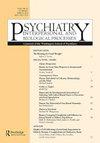Promising New Directions in Addressing the Whole Problem of Suicide.
IF 2.7
4区 医学
Q2 PSYCHIATRY
Psychiatry-Interpersonal and Biological Processes
Pub Date : 2022-01-01
DOI:10.1080/00332747.2022.2132772
引用次数: 0
Abstract
This article by Coppersmith and colleagues tackles a vexing problem within the field of suicide prevention. Although suicide is a major public health concern, suicide-specific behaviors are difficult to predict, effective interventions are limited, few practitioners are trained in them, and many individuals at risk of suicide never receive any treatment. These are all issues the authors clearly explain in the introduction. The field also spent more time than was likely ideal focused on assessing risk and protective factors for suicide and too little time developing and testing suicide-specific interventions. This fact may be one reason why suicide rates within the United States have been stubbornly resistance to reduction over many decades. More recent attention has been paid to the many other factors contributing to the ongoing problem of suicide that must be addressed through means other than clinical interventions. If suicide is treated as the public health crisis that it is, through community-based interventions targeting a broad range of upstream distal contributors to suicide, then the capacity of clinicians to effectively treat those in crisis will not be exceeded. The impact of JITAIs, if effective, on overall suicide rates will likely never be large. But when combined with broad public health interventions they can be a vital component of the overall solution to the problem. And, as the authors clearly explain, there are many challenges which must be addressed before JITAIs can be tested with individuals at risk of suicide. The most significant one, or at least the one that must be tackled first, are the assessment methods used to create the tailoring variable. Currently there are no self-report measures of suicide-specific thoughts and behaviors with sufficient positive and negative predictive power to be used for this purpose. More frequent administration of self-report measures may partially mitigate this problem, but it seems unlikely that will be the ultimate solution. Passive monitoring of physiological correlates of suicide risk is an intriguing idea, and there are some candidate markers worth considering, but work in that area is either purely theoretical (e.g., eye blink rate) or very preliminary (e.g., geolocation of mobility and social contacts). It seems likely that multiple risk data sources will need to be combined and probably differentially weighted to generate a clinically useful risk stratification score used for the tailoring variable. Accomplishing that in real time and in a fully automated fashion will be no small feat.解决整个自杀问题的新方向。
本文章由计算机程序翻译,如有差异,请以英文原文为准。
求助全文
约1分钟内获得全文
求助全文
来源期刊
CiteScore
2.70
自引率
0.00%
发文量
48
审稿时长
>12 weeks
期刊介绍:
Internationally recognized, Psychiatry has responded to rapid research advances in psychiatry, psychology, neuroscience, trauma, and psychopathology. Increasingly, studies in these areas are being placed in the context of human development across the lifespan, and the multiple systems that influence individual functioning. This journal provides broadly applicable and effective strategies for dealing with the major unsolved problems in the field.

 求助内容:
求助内容: 应助结果提醒方式:
应助结果提醒方式:


